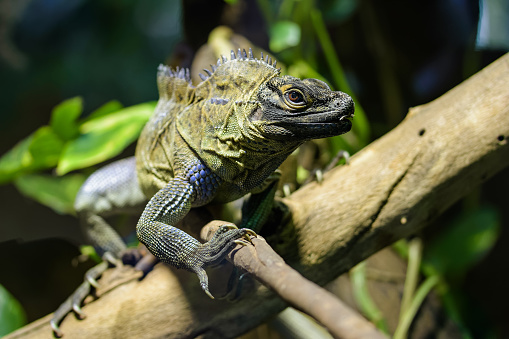ANIMAL: Philippine Sailfin Lizard/Dragon Hydrosaurus pustulatus Type of Animal: Agamid Habitat: Tropical forests, mountain streams, rivers, riverbanks, rice fields, forested river edges, swamps, coastal marshes, woodlands, open cultivated areas Location(s): Philippines Appearance: Males bigger than females w/ bigger crest on back & more colorful, males often have violet color, both sexes have mottled greenish-grey color, distinct sail at tail base in males, juveniles lighter in color, female has dorsal fringe near back & upper surface, some males have neon purple & reddish blue, babies born brown Food/Diet: Crickets, roaches, worms, insect larvae, fruit, berries, greens, vegetables, flowers, legumes, fish, shrimp, crayfish, mice, grasshoppers, snails, cicadas, beetles, moths, leaves, spiders, grains, weeds, grasses, shoots, frogs, melons, crabs Status in Wild: Threatened Conservation: Breeding from zoos, wildlife parks, & private breeders Lifestyle: Solitary Additional Info: Called: Male Female Young-Hatchling Group-Solitary Weight: Male-3-5 lbs Female-2.5 lbs Young-1 lb Gestation: 2 months Life Span: 20-25 years Body Length: Male-3.5 ft Female-2.5 ft Young-1 ft Tail Length: Male-1.3 ft Female-1 ft Main predators of adults are dogs, cats, crocodiles, & large raptors. Many birds, snakes, & large fish prey on young. Threatened due to pet trade, habitat loss, water pollution, & hunting for meat. One of the largest agamid lizards (this family includes sailfin lizards, bearded dragons, agama lizards, spiny-tailed lizards/uromastyx, & many more). Females lay multiple clutches of 2-8 eggs every year. They’re very fast lizards. Sail on males plays important role in territorial displays & for attracting females. Also plays heating/cooling role. Sexually mature at 2 years old. Also called Soa-Soa Water Dragon. Fun Fact(s): Captive individuals often poop, drink, & swim in same water pan, meaning daily water change. They can be very flighty & wild-caught individuals often never tame down. Hand-raised individuals, however, can become very tame. They can hide underwater for up to an hour. The 1st part of their scientific name means water lizard & they’re excellent swimmers. Flee at 1st sight of danger, usually running bipedally into water until they sink/swim away
